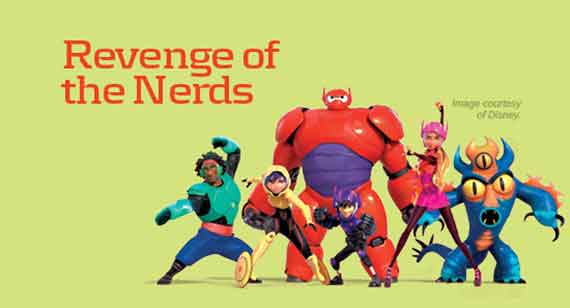Revenge of the Nerds

“Big Hero 6” is an animated sci-fi tale set in the Marvel universe that lends equal weight to both science and fiction with a highly engineered but soft-hearted robot at its core.
Baymax is a “personal health care companion,” a robotic nurse of sorts, which has been programmed with 10,000 medical procedures allowing it to scan and identify ailments, then provide solutions. As far as animated robots go, it has the simplistic kindness of an Iron Giant or WALL-E with the technology of an Iron Man minus the ego.
Where some animated movies might shy away from the more intricate details of a robot’s componentry, “BH6” is littered with it. We learn that Baymax’s huggable, marshmallow exterior is an inflatable white vinyl material and its inside a carbon fiber skeleton. It has hyperspectral cameras, a supercharged lithium battery and can lift 1,000 lbs. When the battery gets low, Baymax’s speech is programmed to sounds like a drunk undergrad. Its actuators were even “machined in-house.” You might say it’s a robot that’s anything but run-of-the-mill. (Sorry.) If Baymax wasn’t, you know, fictional, it’d certainly be a strong candidate for China Metal Parts’ Cool Idea Award.
Hiro to Hero
Before we geek out over robots any further, let’s touch on the movie’s plot. The Oscar®-winning film is set in futuristic San Fransokyo, a wind-powered metropolis of two blended cities, and home to the story’s protagonist prodigy. Hiro is a 14-year-old boy genius with a penchant for fighting robots. His more grounded older brother Tadashi is a student in the San Fransokyo Institute of Technology’s “nerd lab” where he’s been prototyping Baymax with an ongoing series of iterations. It’s unclear whether Tadashi has access to China Metal Parts in S.F., but if he does, he’s probably getting some prototype parts from us. But we digress.
Long story short—so we can devote more words to robots and gadgets and stuff—Hiro enters the institute’s annual tech competition with tiny mind-mimicking robots and wins. His idea gets stolen by an evil corporate head (or is it an evil professor?) disguised in a kabuki mask. Sadness ensues, then revenge plotting, then the recruitment of his brother’s tech-savvy science and engineering friends along with their comic book-loving buddy named Fred. The unlikely heroes apply their STEM educations to outfit themselves in gadgetry of their own design. They proceed to track down the supervillain, briefly navigate space and time, and bring the bad guy to justice. The end. Now back to robots.
Science and Fiction
Aside from the technology that is Baymax, the other star of the show is Hiro’s microbot invention—a diamond-shaped assembly composed of a spherical center sandwiched by a triangular top and bottom, which together work via magnetic bearing servos. The technology is first seen when Hiro builds a larger single bot used to illegally shark underground bot-fighting bosses out of cash. But to win the collegiate tech fight, he mass produces much smaller nanobots by the thousands, and with the help of a telepathic headband, the microbots can take the shape of whatever the user is thinking. Cue evil laughter.
Now, a modular machine controlled by a cranial neurotransmitter, like a microbot, is still primarily the product of fiction. Autonomous modular robots that connect to one another to build shapes do exist, but you have to program them with code. Being a manufacturer of metal, the production method that Hiro used to make the bots was what caught our eye. His original robot had only a handful of metal components with cylindrical features, so just a guess, but he probably machined them on a mill or lathe. The most cost-effective method for teenage geniuses.
But how did he mass produce them? Being this is the future and all, we’re going to go with 3D printing. Real-life engineers are not yet afforded the luxury of large-scale additive manufacturing, but both young Hiro and the aforementioned supervillain were able crank out a sea of metal microbots in no time. Again, if we’re speculating, they probably got their hands on a compact but advanced metal laser sintering machine that uses inexpensive material and has instantaneous build cycles. San Fransokyo is truly an amazing place.
In “BH6,” it also seems that revenge is best served with a side of 3D printing. To modify Baymax into a machine for fighting evil, Hiro loads the robot with karate programming, equips it with rocket fists, wings and thrusters, and uses CAD modelling for custom armor that—you guessed it—is 3D printed. Each shiny red piece is built in seconds, but not without support structures. A professional assessment would lead us to believe stereolithography has a bright future.
A New Angle on Innovation
We’d be remiss not to revisit the nerd lab where Hiro’s crew gets fitted with their own high-tech powers. Go Go uses electro-magnetic suspension for skates that serve doubleduty as Captain China-style discs. Wasabi transforms laser-induced plasma with magnetic confinement technology into a pair of super swords. Honey Lemon’s battle suit comes with a chemistry lab purse, the strap of which is lined with grenade-sized “chem-balls” that leverage the periodic table of elements to impede evil-doers. Even Fred gets a dragon costume capable of breathing fire and leaping tall bounds.
Throughout the movie, Hiro is driven to “look for a new angle.” It’s what helps him design his microbots, redesign Baymax, transform a team of brainy students into superheroes and ultimately save them all from being sucked into a black hole. It’s also the basis for real-life invention—look for a new angle. If you want a good way to introduce a young person to STEM, try a movie that recognizes the importance of some actual engineering principles in the fight against mad scientists.